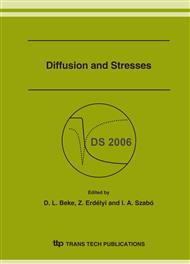[1]
S. E. Donnelly, R. C. Birtcher, and K. Nordlund, Engineering Thin Films and Nanostructures with Ion Beams, edited by E. J. Knystautas (Marcel Dekker, New York, 2005).
Google Scholar
[2]
A. R. Gonzáles-Elipe, F. Yubero, J. M. Sanz, Low Energy Ion Assisted Film Growth, (Imperial College Press, Singapore, 2003).
DOI: 10.1142/p282
Google Scholar
[3]
A. I. Persson, et al., Nature Materials, 3, 677 (2004).
Google Scholar
[4]
R. Timm, et al., Appl. Phys. Lett., 85, 5890 (2004).
Google Scholar
[5]
S. Facsko, T. Dekorsy, C. Koerdt, C. Trappe, H. Kurz, A. Vogt, and H. L. Hartnagel, Science, 285, 1551 (1999).
DOI: 10.1126/science.285.5433.1551
Google Scholar
[6]
V.A. Schukin, N. N. Ledentsov, D. Bimberg, Epitaxy of Nanostructures, Springer (2004).
Google Scholar
[7]
D. L. Beke, Z. Erdélyi, Phys. Rev. B73, 035426 (2006).
Google Scholar
[8]
D. Adamowich, et al., Appl. Phys. Lett., 86, 211915 (2005).
Google Scholar
[9]
P. F. Ladwig, et al., Appl. Phys. Lett., 87, 121912-1 (2005).
Google Scholar
[10]
S. Hofmann, Prog. Surf. Sci., 36, 35 (1991).
Google Scholar
[11]
A. Barna, M. Menyhard, G. Zsolt, A. Koos, A. Zalar and P. Panjan, J. Vac. Sci. Tech. A21, 553 (2003).
Google Scholar
[12]
A. Barna and M. Menyhard, Phys. Stat Sol. (a) 145, 263 (1994).
Google Scholar
[13]
M. Nastasi, J. W. Mayer, J. K. Hirvonen, Ion-Solid Interactions: Fundamentals and Applications, Cambridge, (1996).
Google Scholar
[14]
M. Menyhard, Surf. Interface Anal. 26, 100 (1998).
Google Scholar
[15]
K. Nordlund, Comput. Mater. Sci, 3, 448. (1995).
Google Scholar
[16]
http: /www. mfa. kfki. hu/~sule/animations/cuco. htm.
Google Scholar
[17]
P. Süle, M. Menyhárd, Phys. Rev., B71, 113413 (2005).
Google Scholar
[18]
P. Süle, M. Menyhárd, K. Nordlund, Nucl Instr. and Meth. in Phys. Res., B226, 517 (2004).
Google Scholar
[19]
N. Levanov, V. S. Stepanyuk, W. Hergert, O. S. Trushin, K. Kokko, Surf. Sci., 400, 54 (1998).
Google Scholar
[20]
M. Cai, et al., J. Appl. Phys., 95, 1996 (2004).
Google Scholar
[21]
ASTM E 1127-91. Standard Guide for Depth Profiling in Auger Electron Spectroscopy. ASTM: Philadelphia, PA, (1997).
Google Scholar
[22]
http: /www. srim. org. 6 FIG. 1. The measured depth profile: projectile Ar + , ion energy 1 keV, angle of incidence 84 º . The concentration of Cu is given as a function of the removed layer thickness (measured from the interface in Å). The filled diamonds denote the points at which σ 2 values are determined by AESD. Inset figure: The broadening (σ2) of the interface (Å 2) as a function of the fluence (ion/Å). The dotted lines show the two extreme of the possible slopes (mixing rates). . 7 FIG. 2. The simulated filtered <R2> (SAD, Å 2) as a function of the number of the ion impacts (number fluence) at 1 keV ion energy at grazing angle of incidence using simulated ion-sputtering (molecular dynamics). The dotted line is a linear fit to the <R 2> curves. <R2> is simulated with ion impact points at the free surface (9 ML above the interface) and also at 4 ML above the interface. Inset figure: The simulated filtered <R2> (Å 2) for sputter layer-by-layer removal up to the removal of 4 layers. The error bars are standard deviations.
Google Scholar


